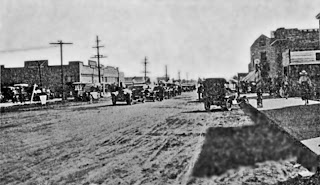 |
| Benjamin, Senior. Driggs Family Archives. |
Benjamin, Jr. had a bevy of siblings since his father, per then-current Mormon doctrine, had more than one wife. (He later served six months in prison for this practice.) On his own, Benjamin Jr. gathered the wherewithal to study at the University of Utah and Brigham Young College (now University). He then attended the University of Michigan Law School.
After graduating in 1886, he practiced law in Provo for two years before moving to Salt Lake City. He would remain in practice there for about fifteen years.
Benjamin also became interested in locating range suitable for stock raising. With much of northern Utah and southeast Idaho already claimed for farm and ranch settlements, he looked further north. In the spring of 1888, he responded to favorable reports about the Teton Valley by inspecting the area himself. Settlers closer to the river advised them to avoid the valley because it was known as “a rendezvous for horse thieves and outlaws.”
Colonists would later learn that the warning had some merit, but it did not deter them. Ben persuaded his younger brother Don, who was not yet married, to start cutting and hauling logs to a site that looked promising for a town.
By the end of 1889, the Valley contained a small colony of Mormon pioneers, including several Driggs family members. Benjamin himself took up a homestead and built a cabin, even though for many years he only spent part of the summer in the Valley. For a time, the structure served as the area’s only mercantile store.
In 1891, he processed a petition to acquire a post office for the new settlement. Because so many names on the petition were Driggs – three brothers and a cousin, along with Benjamin – that name was assigned to the new office. Brother Don became the first postmaster. A decade later, the local Mormons had established the Driggs Ward, with a school and meeting hall, as part of the Teton Stake.
 |
| Driggs, ca 1918. J. H. Hawley photo. |
By then, Benjamin was spending more and more time in the Valley. He moved his family and law practice there in 1903-1905. As de facto village attorney for Driggs, in 1910 he handled the incorporation paperwork for the town.
Soon, the railroad arrived in the village, and it mushroomed: from a population of around 200 in 1910 to about 1,500 eight years later. Besides his law practice, Driggs owned a farm about four miles out of town, where he had a dairy operation. He also invested in city real estate and had an interest in a mining company. (Idaho Statesman, August 30, 1912).
When the legislature established Teton County in 1915, Driggs became the county seat and Benjamin was elected as the first county Prosecuting Attorney. He was re-elected to that position in 1922. In 1926, Caxton Printers, of Caldwell, published the first edition of Benjamin’s History of Teton Valley, Idaho. He passed away in July 1930.
| References: [Hawley] |
| B. W. Driggs, History of Teton Valley, Idaho, Louis. I. Clements and Harold S. Forbush (Eds.), Eastern Idaho Publishing Company, Rexburg (1970) |
| “Benjamin W. Driggs Answers Last Call,” Deseret News, Salt Lake City, Utah (Oct. 2, 1913). |